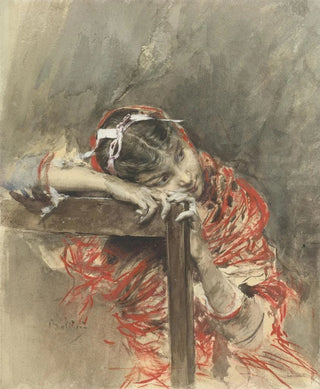Art print | A girl wearing a red shawl - Giovanni Boldini


View from behind

Frame (optional)
In the captivating world of art, some works manage to capture the very essence of beauty and elegance. "Une fille portant un châle rouge" by Giovanni Boldini is undoubtedly one of these memorable creations. Painted at the end of the 19th century, this piece embodies the charm and refinement of the era, while offering a fascinating glimpse into female psychology and sensuality. The composition, both dynamic and delicate, draws the eye and invites deep contemplation. The brilliance of the red shawl, vibrant and lively, contrasts with the softness of the young woman's features, creating a captivating visual dialogue that leaves no one indifferent.
Style and uniqueness of the work
Giovanni Boldini's style is often associated with Impressionism, but he transcends this label through his ability to capture movement and emotion. In "Une fille portant un châle rouge," each brushstroke seems to dance across the canvas, revealing impressive technical mastery. The texture of the shawl, fluid and airy, contrasts with the finesse of the young woman's facial features, which express both a certain melancholy and quiet confidence. Boldini plays with light and shadow, creating reflections that bring the scene to life. This painting is not merely a representation; it is an invitation to feel, to share a moment of intimacy with the subject. The red color, symbol of passion and vitality, is used sparingly, emphasizing the central figure while highlighting the richness of the artist's palette.
The artist and his influence
Giovanni Boldini, born in 1842 in Ferrara, is often regarded as one of the greatest portraitists of his time. His artistic journey took him from Italy to Paris, where he became an essential figure in the artistic scene. His flamboyant style and ability to capture the spirit of his era earned him numerous accolades. Boldini surrounded himself with influential personalities, and his works have been exhibited in the most prestigious art galleries. His influence extends beyond his era, inspiring

Matte finish

View from behind

Frame (optional)
In the captivating world of art, some works manage to capture the very essence of beauty and elegance. "Une fille portant un châle rouge" by Giovanni Boldini is undoubtedly one of these memorable creations. Painted at the end of the 19th century, this piece embodies the charm and refinement of the era, while offering a fascinating glimpse into female psychology and sensuality. The composition, both dynamic and delicate, draws the eye and invites deep contemplation. The brilliance of the red shawl, vibrant and lively, contrasts with the softness of the young woman's features, creating a captivating visual dialogue that leaves no one indifferent.
Style and uniqueness of the work
Giovanni Boldini's style is often associated with Impressionism, but he transcends this label through his ability to capture movement and emotion. In "Une fille portant un châle rouge," each brushstroke seems to dance across the canvas, revealing impressive technical mastery. The texture of the shawl, fluid and airy, contrasts with the finesse of the young woman's facial features, which express both a certain melancholy and quiet confidence. Boldini plays with light and shadow, creating reflections that bring the scene to life. This painting is not merely a representation; it is an invitation to feel, to share a moment of intimacy with the subject. The red color, symbol of passion and vitality, is used sparingly, emphasizing the central figure while highlighting the richness of the artist's palette.
The artist and his influence
Giovanni Boldini, born in 1842 in Ferrara, is often regarded as one of the greatest portraitists of his time. His artistic journey took him from Italy to Paris, where he became an essential figure in the artistic scene. His flamboyant style and ability to capture the spirit of his era earned him numerous accolades. Boldini surrounded himself with influential personalities, and his works have been exhibited in the most prestigious art galleries. His influence extends beyond his era, inspiring






